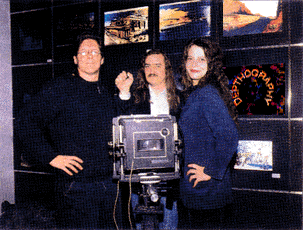|
As seen in Computer Graphics World Magazine - January 1994 · "Cool!" Perhaps not the most insightful response, but that's the reaction many people have upon first seeing one of Depthography Inc.'s 2D pieces of art. Not only do these full-color, 2D images project a 3-D look that is much cleaner & more vivid than your average hologram, if you tilt certain images at just the right angle, you'll suddenly find yourself watching an animation of remarkable sophistication. The images produced by Depthography (New York) are printed on cardboard-like material you can hold in your hand & view with the naked eye. While the drama of the images is difficult to describe in words, the unique quality of the images is obvious to those who've seen them firsthand. One example of Depthography's work is an image of a see-through man. When you hold the image in your hands, the transparent body of the man appears to float several inches above the background of the image. Visible inside the body cavity of the man is his heart as well as some arteries & veins. Even more impressively, when you place your hand on the picture, your fingers appear to actually slip through the man's body to a space somewhere behind it. & if you tilt the image, you can see the man's heart start beating. While all this may sound like a hologram. Depthography balks at the term, noting that the process of creating these images is distinctly different. Holograms, explains Sara Cook, Depthography spokesperson, are produced with lasers, & as such, they have certain limitations. Colors can look washed out & the number of producible colors can be limited, depending on the holographic technique used. In contrast, says Cook, Depthography uses a photographic process to produce its images, & one of the advantages of that is that the images produced are of high resolution & in full color. Additionally, Depthography claims its images have a wider viewing angle than holograms (again, this depends on the holographic technique used), & that its images don't need require specific lighting. Like stereoscopic & holographic technologies, the technology upon which Depthography's process is based - lenticular technology has existed for years. "Other companies use a lenticular process today, like with 3-D baseball cards," says Robert Munn, president & founder of Depthography. "But they typically do their image as a print - not as a photographic process, which is what we do - & that breaks down resolution." Munn, who has been working with stereoscopic images since 1978, took existing lenticular technology as the base for his process, but customized it. "We sort of set out to change the technique to make images more distinct, & then we found out that we could do continuous animation. Everything sort of rolled from there. The process kept revealing to us more & more things we could do with it," says Munn. "In a way, we ended up creating a new medium." It took Munn (along with the help of some friends) six years to develop this lenticular process. Images are typically generated from customers' computer files; acceptable file formats include PICT, TIFF, TGA, EPS, PCS, & SGI. (Depthography also can work with live models, dioramas, mattes, or even a combination of techniques for varying effects.) To create these effects, Depthography interlaces as many as 36 frames (computer screens) into one image. Says Munn, "For example, we'll take a 3D image from a computer file, put the image on screen, rotate it, say, 12 to 15 degrees & while its rotating capture 36 images across that area." The digital file is converted into a film product, onto which an optical screen is applied. The result is a somewhat thick (about 1/8 inch) yet flat image that can protrude, move, or protrude & move. "The optical screen that we apply to the surface of the image acts as an automatic viewer, sampling what you see," says Munn. "So depending on the position you hold the image in (or where you are standing), you see a different frame." The results are pretty spectacular. For example, another image recently produced by Depthography is a photo called "Muhammad Ali in Action" that actually replays the left hook Ali delivered to Cleveland Williams back in 1966. By rotating the photo, you can see a dramatic animation of Ali delivering the lethal punch. & by simply moving the image back & forth, you can see the punch delivered over & over again - fast or slow. You can also see the first few rows of the audience seated around the ring. One man appears to be chewing gum as you rotate the image, another man with a camera moves into position to take a photo. It's a "cool" image, to be sure, & typical of the kind of images Depthography regularly produces for its clients. But if you want to view these "cool" images yourself, you can do that too, says Cook. Just drop by Depthography's Virtual Image Gallery in New York, where the images are on display. Donna Coco, Associate Editor,
To read more interesting articles & perhaps subscribe to this magazine, go to http://www.cgw.com Copyright, All Rights Reserved.
If you would like to join our email mailing list for upcoming 3d events, please email your request to info@depthography.com. Click here for the Robert Munn bio. Click here for the Sara Cook bio. |


